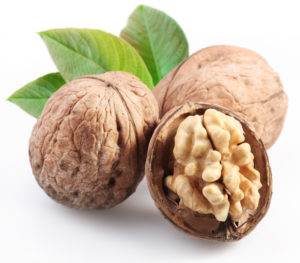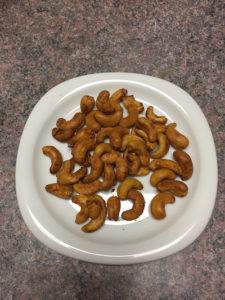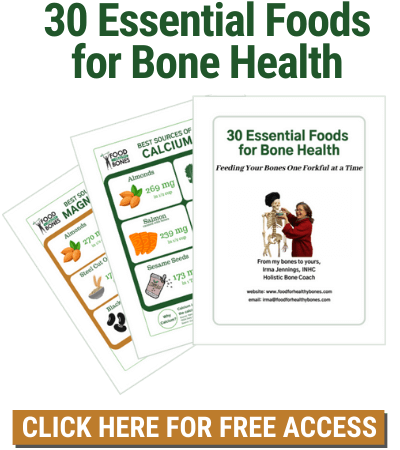Nothing I like more than a handful of crunchy nuts for a snack. And Skelly’s with me on this.
You see, nuts are full of healthy fats, protein, and fiber that fill you up. But they are also a treasure box of minerals that build strong bones.
Maybe you have a favorite nut that you keep on hand. But I want you to think about rotating your nuts or eating lots of mixed nuts. That’s because each type of nut offers something special for your bones. If you stick to just one you’re missing out.
Here are the nuts I like best and what they do for your bones:
Almonds:
These have the highest calcium levels of all nuts. One serving gives you about 200 mg of calcium. Plus they give you 240 mg of potassium and 20 percent of your daily magnesium needs to support bone building.

Walnuts:
Just a quarter cup of these nuts gives you 2.25 grams of omega-3 fats. That’s important because omega-3s help increase the amount of calcium your body absorbs and deposits in your bones. It also boosts collagen production which improves bone strength.[i]
Research shows that walnuts help slow down osteoclast activity (bone breakdown) and increase osteoblast activity (bone formation).[ii] In one Penn State study people who ate lots of walnut granola, honey walnut butter, and walnut pesto had slower rates of bone breakdown.[iii]
And with walnuts you also get a good source of some of the trace minerals your bones love like boron, copper, and manganese.

Other nuts that Skelly likes are :
- pistachios
- cashews
- hazelnuts.
They’re all high in magnesium.
And just one Brazil nut a day will give you all the selenium you need.
But before you start chowing down on nuts, I want you to be careful…
Nuts can be pretty difficult to digest for some people.
Like grains, legumes, and seeds, nuts contain phytates or phytic acid. Phytates are nature’s way of protecting nuts from predators. You know how acorns grow into trees? Well, that can happen with any nuts. But phytates keep the nut in a dormant state until it’s ready to grow.
If you eat nuts with the phytic acid intact, it can put a lot of stress on your digestive system. It can interfere with the enzyme pepsin that we use to break down proteins in the stomach. It can also interfere with the enzyme amylase that you need to break down starches.
Phytic acid can also bind to minerals in the nuts like calcium, zinc, magnesium, and iron. Studies suggest that we absorb about 20 percent more zinc and 60 percent more magnesium from food without phytic acid.[iv]
But before you cut nuts out of your diet because of phytates, here’s what you need to know…
Some people with strong gut flora have no problem with phytates. They can naturally break down phytic acid and don’t get digestive problems.[v]
And phytates in nuts may actually help you build stronger bones. One Spanish study found that people who eat more high-phytate foods had stronger bones as measured in the heel, spine, and hip.[vi] Researchers suspect that phytates may inhibit the breakdown of bone.
A later study also found better bone density in women who ate the most phytate foods. It found that women with the highest phytate levels had the lowest levels of bone loss in their spine and hip.[vii]
So as long as nuts don’t give you indigestion....
......don’t worry about the phytates. They may help your bones.
But if you are one of those people who have problems digesting nuts, you can try soaking them before eating them. When you add water, the phytic acid is neutralized and the nut starts to sprout.
You won’t see the sprouting but a small change happens in the nut so you can now digest it more easily and absorb more of the minerals.
How To Soak Nuts
Here’s the simple way to soak and dry your nuts. Put raw (not roasted) nuts in a bowl and cover with filtered water. Add one tablespoon of pure unrefined sea salt for every four cups of nuts.
Let soak for at least 7 hours or overnight. This works for most nuts but cashews and peanuts should be soaked for no more than 6 hours or they’ll get slimy. Yuck!
Then you have to fully dry your nuts or they could become moldy.
Ideally you should dry them at 150 degrees Fahrenheit in a dehydrator or your oven for 12 to 24 hours or until they’re as crunchy as you like them.
To test the crunchiness, take out one of nuts and let it cool to room temperature. Then bite into it. You know how crunchy you like them.
Need a shortcut?
You can dry your nuts in the oven at 200 degrees Fahrenheit for 30 to 40 minutes. You may lose some of the nutrients at the higher heat but you’ll still have some very healthy nuts.
Just make sure you start by buying fresh nuts. Nuts still in the shell are the freshest. But shelling adds a lot of work to the soaking and drying process. If you’re in a hurry buy them already shelled.
And store your nuts in an airtight container so they don’t go rancid. They’ll keep fresh in the fridge for about six months and in the freezer up to a year.
Here’s one of my favorite go to snacks.

Spicy Cashews
Ingredients:
- 9 oz of raw organic cashews
- Juice of 1/2 lemon
- Tandoori spice
- Sea salt
Preparation:
- Soak cashews in water overnight
- In morning rinse soaked cashews
- Drain and pat dry with paper towel (skip the soaking step if you digest nuts well)
- Add lemon juice
- Coat with 1 tablespoon of Tandoori Seasoning (I use my hands for this)
- Evenly distribute on a baking sheet so they are spread out and bake evenly
- Bake in oven at 300 degrees F for 40 minutes
- Stir every 10 minutes
- And then stand back……cause everyone will eat ‘em up
- Storage: place in a tightly sealed jar and leave jar on the counter
- Good for 2-3 weeks
Tandoori Seasoning
Ingredients:
- 1 teaspoon ground ginger
- 1 teaspoon ground cumin
- 1 teaspoon ground coriander
- 1 teaspoon paprika
- 1 teaspoon turmeric
- 1 teaspoon sea salt
- 1/4-1/2 teaspoon cayenne pepper depending on taste
Printable version HERE
I love my community.
This blog is an expanded post after feedback from Karen Jorgensen. Thank you, Karen!
Please let me know how I can better serve you and your bones.
There is an easy alkalizing salad dressing video gift for you on the other side for your time.
Have your bones click —-> HERE
Thanks for stopping by.

Irma and Skelly

Let Me Support Your Bones
Get Customized In-Depth Private Session
Book a Private Coaching with Irma Now
Join Our Amazing Bone Tribe Community
Get the support & information you need to live fearlessly with your bones diagnosis
From my bones to yours,
Irma Jennings, INHC
Your Holistic Bone Coach
[email protected]

